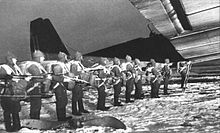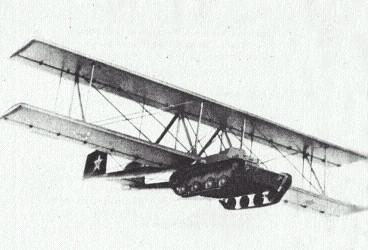Ensimmäisen maailmansodan loppuvaiheissa prikaatinkenraali Billy Mitchell ehdotti, että Yhdysvaltain 1. jalkaväkidivisioonan osia olisi pudotettu saksalaisten linjojen taakse lähellä Metzia. Sota loppui ennen kuin tällaista hyökkäystä ehdittiin vakavasti suunnitella. On epäselvää, miten operaatio olisi voitu toteuttaa senaikaisilla laskuvarjoilla ja lentokoneilla.
Ensimmäinen oikea laskuvarjoilla tehty joukkojen pudotus tapahtui Italiassa marraskuussa 1927. Muutaman vuoden kuluessa perustettiin useita pataljoonia ja ne ryhmitettiin eliittidivisiooniin Folgore ja Nembo. Kuitenkin vaikka nämä osastot taistelivat toisessa maailmansodan, niin niitä ei koskaan käytetty laskuvarjopudotuksiin.

Suunnilleen samoihin aikoihin Neuvostoliitossa tehtiin myös kokeiluja, suunnitelmissa oli jo pudottaa kokonaisia yksiköita ajoneuvoineen.
Venäjän maahanlaskujoukkojen katsotaan saaneen alkunsa 2. elokuuta 1930, kun Moskovan sotilaspiirissä ilmavoimien harjoituksessa laskettiin maahan laskuvarjoilla 12 sotilasta. Ensimmäinen yksikkö, joukkueen vahvuisena osastona muodostettiin 1931. Operaatio Barbarossaan mennessä Neuvostoliitolla oli noin 10 000 sotilaan vahvuiset maahanlaskujoukot.

Neuvostoliitossa ensimmäiset suuret laskuvarjoharjoitukset pidettiin 1932, josta saksalalaiset saivat vaikutteita.
Kouluttaakseen tarpeeksi kokeneita hyppääjiä ympäri Neuvostoliittoa perustettiin laskuvarjokerhoja, joista sitten tarvittaessa voitiin siirtää osaavat jäsenet armeijaan. Suunnitelma edistyi niin, että jo vuonna 1936 suuria pudotuksia esiteltiin ulkomaisille tarkkailijoille.

Yksi tarkkailijoista, Saksa, oli erityisen kiinnostunut. Vuonna 1936 majuri Immans määrättiin perustamaan laskuvarjokoulu, jonka käyttöön annettiin useita Junkers Ju 52 -lentokoneita. Asevoimat olivat jo hankkineet suuria määriä Junkers Ju 52 -lentokoneita, joihin tehtiin nyt pieniä muutoksia laskuvarjosotilaiden kuljettamista varten.
Myös muut valtiot, kuten Japani, muodostivat maahanlaskujoukkoja samaan aikaan.
----------------------------------------------------------------
The first airborne forces parachute jump is dated to 2 August 1930, taking place in the Moscow Military District. Airborne landing detachments were established after the initial 1930 experimental jump, but creation of larger units had to wait until 1932-33.
On 11 December 1932, a Revolutionary Military Council order established an airborne brigade from the existing detachment in the Leningrad Military District. To implement the order, a directive of the Commissariat of Military and Naval Affairs transformed the Leningrad Military District’s 3rd Motorised Airborne Landing Detachment into the 3rd Airborne Brigade (Special Purpose) commanded by M.V. Boytsov.

Two further airborne brigades (the 13th and 47th) and three airborne regiments (the 1st, 2nd, and 5th, all in the Far East) were created in 1936.[4] In March and April 1941, five Airborne Corps were established on the basis of the existing 201st, 204th, 21lth, 212th, and 214th Airborne Brigades. The number of Airborne Corps rose from five to ten in late 1941, but then all the airborne corps were converted into "Guards" Rifle Divisions in the northern hemisphere summer of 1942.
The Soviet airborne forces were mostly used as 'foot' infantry during the war. Only a few small airborne drops were carried out in the first desperate days of Operation Barbarossa, in the vicinity of Kiev, Odessa, and the Kerch peninsula.

The two significant airborne operations of the war were the Vyazma operation of February–March 1942, involving 4th Airborne Corps, and the Dnepr/Kiev operation of September 1943, involving a temporary corps formation consisting of 1st, 3rd, and 5th Airborne Brigades. Glantz writes: "After the extensive airborne activity during the winter campaign of 1941-42, the airborne forces underwent another major reorganization the following summer.
Responding to events in southern Russia, where German troops had opened a major offensive that would culminate in the Stalingrad battles, the ten airborne corps, as part of the Stavka strategic reserves, deployed southward. Furthermore, the Stavka converted all ten airborne corps into guards rifle divisions to bolster Soviet forces in the south. Nine of these divisions participated in the battles around Stalingrad, and one took part in the defense of the northern Caucasus region."
The Stavka still foresaw the necessity of conducting actual airborne operations later during the war. To have [such a force] the Stavka created eight new airborne corps (1st, 4th, 5th, 6th, 7th, 8th, 9th, and 10th) in the fall of 1942. Beginning in December 1942, these corps became ten guards airborne divisions (numbered 1st, 2nd, 3rd, 4th, 5th (formed from 9th Airborne Corps (2nd formation)), 6th, 7th, 8th, 9th, 10th, two formed from the 1st Airborne Corps and the three existing separate maneuver airborne brigades). The new guards airborne divisions trained in airborne techniques, and all personnel jumped three to ten times during training.
After the defeat of German forces at Kursk, the bulk of the airborne divisions joined in the pursuit of German forces to the Dnepr River. Even as ten guards airborne divisions fought at the front, new airborne brigades formed in the rear areas. In April and May 1943, twenty brigades formed and trained for future airborne operations. Most of these brigades had become six new guards airborne divisions (11th through 16th) by September 1943.
The Stavka however, earmarked three of these airborne brigades use in an airborne operation to cross the Dnepr River.

Ei kommentteja:
Lähetä kommentti
Any explosive ammunition or empty cores, you can put in this.